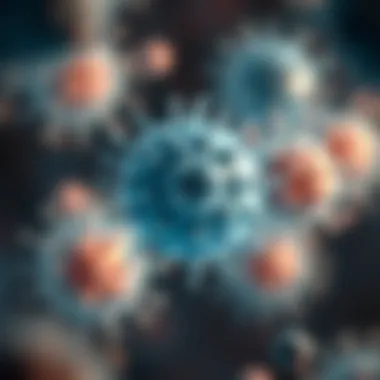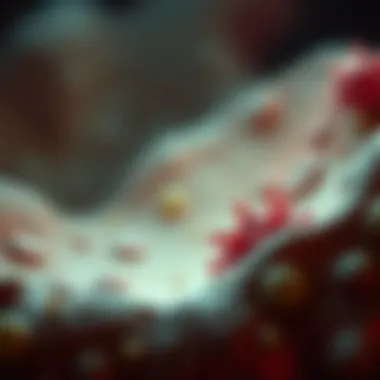Understanding In Situ in Cancer Research: Insights and Implications


Intro
Cancer research constantly evolves, digging deeper into how malignancies operate. One key concept that stands out is the term in situ. This phrase, which stems from Latin meaning "in its original place," carries significant weight in the diagnosis and treatment realms of cancer.
Understanding cancers that are described as in situ offers invaluable insights into early-stage disease processes and paves the way for effective management strategies. These are tumors that remain localized, confined to their site of origin, without invading nearby tissues. Grasping the nuances of in situ cancers could remarkably influence patient outcomes, making this a crucial topic for professionals and learners alike.
In situ cancers are rather like a spark in a forest that's been contained, preventing it from leading to a raging inferno. Essentially, identifying them allows for a more tailored approach to treatment, which can be less aggressive than what would be required for invasive cancers.
This article aims to break down the complexities of in situ cancers. We will explore recent advances, such as groundbreaking discoveries and technological innovations, which have transformed how we perceive and approach in situ malignancies. Furthermore, we'll delve into the methodological frameworks guiding research in this area, ensuring a comprehensive understanding for anyone invested in cancer research and management.
Defining In Situ
The term "in situ" plays a pivotal role in the realm of cancer research. Its meaning, translating from Latin as "in its original place," encapsulates specific aspects of tumor development, distinguishing them from more aggressive forms of disease. Defining in situ cancers not only provides clarity for researchers but also informs treatment protocols and patient management strategies. A solid grasp of this term is essential for healthcare professionals as it influences diagnostic criteria and therapeutic approaches that can save lives. Understanding in situ lesions is especially crucial given how early detection can alter the trajectory of a patient's health.
Origins of the Term
Historically, the term "in situ" emerged from the medical lexicon to describe cells or tissues that remain in their original location, yet exhibit abnormal growth or changes. The formal usage began gaining traction in the mid-20th century as pathologists sought a precise vocabulary to characterize tumors. Originally, the term encompassed a range of conditions, but its application has become more refined through ongoing research. It's become a cornerstone in distinguishing between early-stage cancers and advanced disease, allowing healthcare providers to adopt tailored management strategies.
In Situ vs. Invasive Cancers
Understanding the difference between in situ and invasive cancers is paramount in cancer care. In situ cancers, like ductal carcinoma in situ (DCIS), are confined to the tissue of origin and do not invade surrounding structures. This distinction matters significantly because, without invasion, the risk of metastasis is considerably lower. On the other hand, invasive cancers break through the basement membrane and can infiltrate surrounding tissues and spread to other parts of the body.
Recognizing these differences impacts not only prognosis but also treatment decisions. In situ lesions generally have more favorable outcomes compared to their invasive counterparts. The management of in situ cancer conditions often involves surgery or sometimes monitoring, while invasive cancers might necessitate combinations of surgery, chemotherapy, or radiation.
In situ cancers, while still serious, often represent a stage where interventions can prevent progression to invasive disease. This potential for interception is what makes understanding in situ so critical.
To summarize, defining in situ provides an essential framework for navigating the complexities of cancer. It supports the delineation of treatment paths based on the nature of the tumor, while emphasizing the importance of early detection and intervention.
Clinical Implications
Understanding clinical implications of in situ cancers is crucial for both practitioners and patients alike. In this realm of cancer research, recognizing how in situ lesions behave differently from their invasive counterparts can guide treatment decisions and influence survival rates. Research indicates that in situ forms are often detectable at earlier stages, raising the importance of effective screening practices and timely diagnoses. Early interventions can significantly improve outcomes, especially considering that these cancers are confined to their original site and have not spread at the time of detection.
Diagnosis of In Situ Lesions
Diagnosing in situ lesions typically begins with imaging techniques like mammograms for breast cancer or Pap smears for cervical carcinoma. These methods allow for identifying abnormalities before they progress to invasive stages. The process might also include biopsies to confirm the diagnosis. In a society that places heavy emphasis on early detection, clinicians take a proactive stance, utilizing both conventional and novel techniques.
The role of pathologists is pivotal in this judgment process. They examine the biopsy samples under a microscope, looking for the characteristic features of in situ lesions. Tools such as immunohistochemistry help to identify specific biomarkers, adding another layer of detail to the diagnosis. Once a diagnosis is made, a thorough discussion between the healthcare team and the patient occurs to devise the next steps.
"The importance of accurate diagnosis cannot be overstated, as it directly influences treatment plans and patient resilience."
Prognostic Factors
When it comes to prognostic outlooks for in situ cancers, several factors come into play that aid physicians in determining the appropriate management. Some key aspects include:
- Histological features: The cell type and grade can indicate aggressiveness, shaping treatment choices.
- Size of the lesion: Larger lesions may carry a higher risk, even in their in situ form, prompting closer monitoring.
- Margins of the biopsy: Clear margins suggest that the entire lesion has been removed, which can lower recurrence chances.


Quantitative statistics such as five-year survival rates for in situ breast cancer are often much higher than for invasive types. For instance, women diagnosed with Ductal Carcinoma In Situ (DCIS) have favorable outcomes, with studies suggesting a 98% survival rate at five years post-diagnosis. This underscores the significance of understanding both the characteristics of the cancer and the overall health of the patient. Using a tailored approach based on these prognostic factors allows for personalized care, resonating deeply within the broader field of oncology.
Types of In Situ Cancers
In situ cancers represent a critical intersection of biology and medical intervention. Understanding different types of in situ cancers allows researchers and medical professionals to tailor strategies for prevention, early diagnosis, and effective treatment.
Among the myriad of cancers, two types stand out: Ductal Carcinoma In Situ (DCIS) and Cervical Carcinoma In Situ. Both play significant roles in their respective fields and have distinct characteristics and management approaches that warrant attention.
Ductal Carcinoma In Situ (DCIS)
Ductal Carcinoma In Situ (DCIS) is a non-invasive breast cancer that originates in the lining of the milk ducts. It has become a focal point in the discussion of breast cancer because of its unique presentation and implications for treatment.
Characteristics of DCIS
One of the defining characteristics of DCIS is that it does not invade surrounding breast tissues. Instead, the cancerous cells are confined to the ducts, making early detection paramount. This containment means that, when detected early, DCIS has a high survival rate, often nearing 100% with appropriate intervention.
The non-invasive nature of DCIS challenges the traditional perception of cancer. Many medical professionals argue that while it presents a risk for developing invasive breast cancer, not all cases will progress to that stage. This concept is somewhat contentious; hence, understanding DCIS helps in honing a more patient-centered approach to treatment decisions.
Statistics and Outcomes
Statistics regarding DCIS are particularly compelling. The incidence of DCIS has risen significantly in recent decades, largely due to widespread screening methods like mammograms. An estimated 25% of all breast cancer diagnoses are now attributed to DCIS.
The outcomes for patients with DCIS are predominantly favorable, but there are important nuances to consider. While the five-year survival rate is incredibly high, ongoing monitoring and treatment choices can vary widely based on individual factors, including age, family history, and tumor characteristics. This variability can add layers of complexity when discussing management and prognostics with patients.
Cervical Carcinoma In Situ
Cervical Carcinoma In Situ is another pivotal type of in situ cancer, most frequently associated with human papillomavirus (HPV) infection. Understanding this cancer type is crucial as it links directly to preventive measures and screening practices.
Prevalence and Screening
Cervical cancer, in its in situ form, is often caught during routine screenings, such as Pap tests. The prevalence of cervical carcinoma in situ has seen a decline due to these screening methods, marking a significant public health achievement. Many women, especially those within designated age groups, benefit from early detection, making screening a powerful ally in combating cervical cancer.
Statistically, the survival rates for women diagnosed with cervical carcinoma in situ are favorable, but disparities exist. Access to healthcare and variations in screening participation can create gaps in outcomes among different populations.
Treatment Approaches
When it comes to treating cervical carcinoma in situ, options typically include excisional procedures such as the Loop Electrosurgical Excision Procedure (LEEP) or even conization. The choice often hinges on the extent of the lesion and the patient’s reproductive desires. While these methods are effective, they also bring forth potential complications and implications for future pregnancies, making informed decision-making essential.
Ultimately, the management of in situ cancers, whether DCIS or cervical carcinoma in situ, demands a thoughtful blend of clinical knowledge and patient engagement. As such, ongoing research and dialogue in this area remain crucial for evolving our understanding and treatment strategies.
Research Methodologies
Research methodologies serve as the backbone in understanding in situ cancers. They not only shape how we gather and analyze data but also inform clinical practices and patient outcomes. With the right methodologies, researchers can draw significant insights on the patterns of in situ carcinoma, how they progress, and implications for treatment strategies.
Utilizing a variety of methodologies enhances the richness and relevancy of the findings. For instance, epidemiological studies can reveal the prevalence and distribution of in situ cancers within populations, thereby guiding healthcare policies and screening recommendations. On the other hand, histopathological analysis offers a microscopic view of tissues, allowing researchers to identify the distinct features of in situ lesions as compared to their invasive counterparts.
Importance of Methodology in Cancer Research


- Consistency: Appropriate methodologies ensure that studies are consistent and replicable.
- Accuracy: Correctly applied methods minimize bias and increase accuracy in data collection.
- Innovation: Research methodologies evolve, leading to novel approaches in the assessment and treatment of in situ cancers.
"The right research methodology can mean the difference between a study having a profound impact and it simply gathering dust in the archives."
Furthermore, integrating various methodologies supports a multidimensional understanding of cancers that are classified as in situ. Such integration not only strengthens the validity of research findings but also lays the groundwork for more targeted approaches in patient care.
Epidemiological Studies
Epidemiological studies play a crucial role in cancer research, particularly in assessing the public health implications of in situ cancers. These studies focus on the distribution and determinants of health-related states or events in specified populations. By examining factors such as demographics, lifestyle choices, and environmental exposures, researchers can construct a clearer picture of who is at risk.
In situ cancers, although non-invasive, can signal underlying risks that may emerge later. For example, understanding the risk factors associated with Ductal Carcinoma In Situ (DCIS) can lead to targeted surveillance strategies for high-risk groups. Key aspects of these studies include:
- Cohort Studies: Following a group over time to assess incidence and outcomes.
- Case-Control Studies: Comparing individuals with in situ cancers to those without to identify potential risk factors.
- Population-Based Registries: Maintaining comprehensive data sets that track cancer incidence and survival rates.
Such insights are indispensable for healthcare providers, equipping them with the information required to implement effective public health interventions.
Histopathological Analysis
Histopathological analysis is indispensable for diagnosing and understanding the complexities of in situ cancers. This methodology involves examining tissues under a microscope to identify cellular characteristics that define a lesion.
With in situ cancers, the analysis highlights differences between benign and malignant growths, often catching changes before they become invasive. This method provides critical insights into:
- Cellularity: Assessing the number and appearance of cells, which can indicate abnormal growth.
- Architecture: Observing the layout of tissue can reveal disorganization associated with neoplastic processes.
- Molecular Markers: Identifying specific biomarkers can aid in tailoring therapeutic approaches.
Histopathological findings often guide treatment decisions, helping doctors determine whether surgical or non-surgical interventions are warranted. A careful and thorough evaluation is essential, as it can affect long-term patient management strategies, including follow-up care and the need for meticulous surveillance, particularly in cases such as Cervical Carcinoma In Situ.
The Evolution of In Situ Definitions
The concept of 'in situ' has undergone substantial reevaluation since its inception. Understanding the evolution of these definitions is crucial in cancer research. It shapes the clinical landscape, guides treatment decisions, and affects patient outcomes. As researchers and practitioners delve deeper into the cellular and molecular mechanisms of cancer, the nuances of in situ definitions continue to evolve, impacting how lesions are classified, diagnosed, and treated.
Historical Context
In the past, the characterization of in situ tumors was heavily anchored in anatomical pathology and the histological changes observed in tissue samples. Early definitions primarily focused on morphological criteria, offering a simplistic view that categorized cancers based solely on their structural characteristics. This binary approach—matching what was deemed invasive versus non-invasive—did a disservice to the complexities of tumor biology. Gross observations were often the guiding factors for classification.
A pivotal moment in this evolution came with the identification of Ductal Carcinoma In Situ (DCIS) in the 1980s. This shifted attention to the biological behaviors of tumors rather than just their locations. The increasing incidence of DCIS highlighted flaws in previous classification systems, raising questions regarding the need for a more nuanced understanding of tumor biology. Additionally, the advent of molecular biology techniques allowed for deeper explorations into the genetics behind these lesions. Researchers began to grasp that in situ tumors could represent a spectrum, each with varying degrees of potential for invasion.
Current Consensus
Today, there exists a more refined understanding of in situ cancers. The current consensus acknowledges that in situ lesions may share histological features with invasive cancers, but they remain localized, confined to the site of origin without spreading to surrounding tissues. This distinction is critical in determining treatment approaches and patient management strategies.
The dialogue surrounding in situ cancers now incorporates a variety of perspectives:
- Biological Behavior: There is a growing emphasis on monitoring genetic markers and patterns of cell behaviour. Understanding the biological characteristics of an in situ tumor can impart crucial insights into its potential progression.
- Guidelines: Guidelines from expert entities, including the American Joint Committee on Cancer (AJCC), have been updated to reflect emerging evidence, calling for clearer definitions that differentiate in situ lesions from their invasive counterparts.
- Risk Stratification: Current research distinguishes between various types and grades of in situ cancers, enabling clinicians to better stratify patients by their risk of progression. Recognizing that not all in situ lesions behave similarly helps shape individualized treatment plans.
To summarize, the evolution of in situ definitions in cancer research is a vital narrative that underscores the dynamic interplay between emerging knowledge and clinical practice. As our understanding advances, so too does our ability to improve diagnostic accuracy, tailor treatment options, and ultimately enhance patient outcomes.
"The continuing evolution of in situ definitions illuminates the journey from basic anatomical categorizations to nuanced, biologically informed frameworks that enhance our ability to combat cancer."


This ongoing discussion plays a significant role in ensuring that healthcare providers remain informed and capable, adapting to the shifting sands of cancer research that inevitably impact their practice.
Management Strategies
Management strategies for in situ cancers are of paramount importance in shaping effective treatment protocols and improving patient outcomes. These strategies focus not just on addressing the tumor itself, but also on the broader implications for patient health and quality of life. Understanding the landscape around in situ management is crucial for optimizing care and enhancing survivability, making it an essential topic in cancer research.
Surgical Interventions
Surgical interventions form the cornerstone of management for in situ cancers. The primary goal here is to achieve complete removal of the tumor while attempting to preserve surrounding healthy tissue. For instance, the surgical treatment for Ductal Carcinoma In Situ (DCIS) often involves a lumpectomy, also known as breast conservation surgery. This approach allows for the excision of the cancer while minimizing the need for more invasive procedures like mastectomy.
Moreover, the effectiveness of surgical interventions can be significantly impacted by factors like tumor size, location, and patient factors such as age and overall health. It's not just cut and dry; the decisions made in the operating room are crucial for long-term outcomes. A thorough understanding of pathology and tumor biology helps surgeons determine the most appropriate interventions.
A key consideration is the margin of healthy tissue around the tumor. Achieving clear margins—meaning no cancer cells are present at the edges of the excised tissue�—plays a critical role in reducing recurrence rates. Thus, adequate pre-operative imaging and careful surgical planning become vital elements.
For many patients, the prospect of surgery can be daunting. Not only are the physical implications significant, but the psychological impact should not be overlooked. Supportive care measures are integral pre- and post-surgery to address patient anxiety and ensure they feel part of their care journey.
Surgical Risks
- Complications such as infection or delayed healing.
- Potential for changes in physical appearance, especially in breast surgeries.
- Need for further interventions if margins are not clear.
The success of surgical management is often followed by a tailored post-operative plan, which leads us to the next crucial aspect of management strategies.
Follow-Up Care
Follow-up care serves as a vital bridge in the journey of an individual after surgical interventions for in situ cancers. Regular monitoring through clinical exams and imaging tests helps manage any potential complications and allows for early detection of recurrences if they occur.
In scenarios like DCIS, where risk of invasive breast cancer remains post-treatment, patients are advised to engage in routine screening and follow healthcare provider recommendations. The schedule for follow-ups typically varies based on the individual's risk factors and the specifics of their surgery but generally falls within a framework of regular intervals throughout the year.
Moreover, follow-up care extends beyond medical evaluations. Psychological and emotional support, such as counseling or support groups, might be necessary, particularly given the potential for anxiety around cancer. Educating patients about signs of recurrence can empower them, fostering a proactive approach to their health.
Future Directions in Research
The future of in situ research is a frontier marked by potential breakthroughs and innovative methodologies. As scientists push the envelope of understanding cancer biology, particularly in non-invasive contexts, new strategies are emerging that promise to revolutionize diagnosis and treatment. The focus on future directions is not just about enhancing existing techniques, but also about recognizing the importance of understanding the unique characteristics of in situ lesions. This understanding can lead to better outcomes and more personalized treatments.
Novel Diagnostic Techniques
Advances in diagnostic techniques present a canvas of possibilities for researchers. The traditional methods, like biopsy, have been increasingly supplemented with cutting-edge technologies. Here are some notable advancements:
- Liquid Biopsy: This technique analyzes cancer-related components found in blood samples. It offers a less invasive option to detect in situ cancers, leading to quicker and easier assessments.
- Molecular Imaging: Techniques such as PET (Positron Emission Tomography) and MRI (Magnetic Resonance Imaging) are becoming more refined. They allow for mapping out aberrant cellular behavior without the need for invasive procedures.
- Artificial Intelligence (AI): AI algorithms help in evaluating vast amounts of data, offering new insights into cancer pathology. This technology can analyze imaging results more efficiently than any human and might catch anomalies that would otherwise go unnoticed.
These techniques collectively create a more comprehensive toolbox for early detection and intervention.
"The sooner cancer is spotted, the higher the chances of successful treatment."
One crucial consideration as these technologies develop is the need for robust validation and regulatory compliance to ensure their clinical effectiveness and safety.
Potential for Immunotherapy
Immunotherapy has gained considerable traction in recent years. For in situ cancers, its potential is particularly promising. Unlike traditional therapies that primarily focus on the tumor itself, immunotherapies harness the body's immune system to identify and destroy cancerous cells. By focusing on the microenvironment around in situ tumors, researchers are looking to enhance the effectiveness of these treatments.
- Checkpoint Inhibitors: These drugs work by taking the brakes off the immune system, effectively allowing it to recognize and attack cancer cells categorized as in situ.
- Therapeutic Vaccines: They aim to provoke a robust immune response against in situ cancer cells. By training the immune system to identify these cells more effectively, there's potential for preventing progression to invasive disease.
- Combination Therapies: Coupling immunotherapy with other modalities like surgery or radiation shows promise in bolstering treatment effectiveness.
The consideration here is not only about efficacy but also about the risk of adverse reactions. Tracking patient responses in conjunction with these novel therapies can provide valuable data for refining treatment protocols.















